Abstract
61 biopsies of normal skin from the deltoid area and lesional skin from various sites from 48 patients with systemic lupus erythematosus (SLE) were studied for the presence of properdin, C3, C4, and immunoglobulins (IgG, IgM, and IgA) in the dermal-epidermal junction (DEJ) using direct and indirect immunofluorescence. Properdin was present in 50% of normal and 40% of lesional skins. Properdin was present without C4 in only 2 of 38 nonlesional skin biopsies and in only 2 of 20 lesions. There was no significant difference in incidence of deposition of any of the six proteins studied between nonlesional and lesional skin. The frequency of deposition of each of the proteins correlated with clinical disease activity. The presence of proteins in the DEJ did not correlate with the presence of active renal disease at the time of biopsy nor with previously documented active nephritis. In addition, no other single clinical manifestation correlated with the presence of DEJ deposition of any protein studied. IgA was not demonstrated in the DEJ of nonlesional skin of 16 patients in remission and was present in 7 of 23 patients with active disease (P less than 0.05). Deposition of properdin in lesional skin correlated with the presence of extracutaneous disease activity (P less than 0.05). Analysis of serologic studies on serum obtained at the time of biopsy revealed a statistically significant correlation between C4 and C3 (r = 0.67). This correlation was stronger than that between properdin and C4 (r = 0.37). Titer of antinuclear antibody and percent of DNA binding correlated better with C4 levels than with properdin levels. Serum properdin levels were significantly lower in patients with active disease than in those in remission (P less than 0.05). Serum properdin levels were significantly lower in patients with properdin deposits in lesional skin than in those without properdin deposits. The data suggest that both alternative and classical pathways are activated in patients with clinically active SLE.
Full text
PDF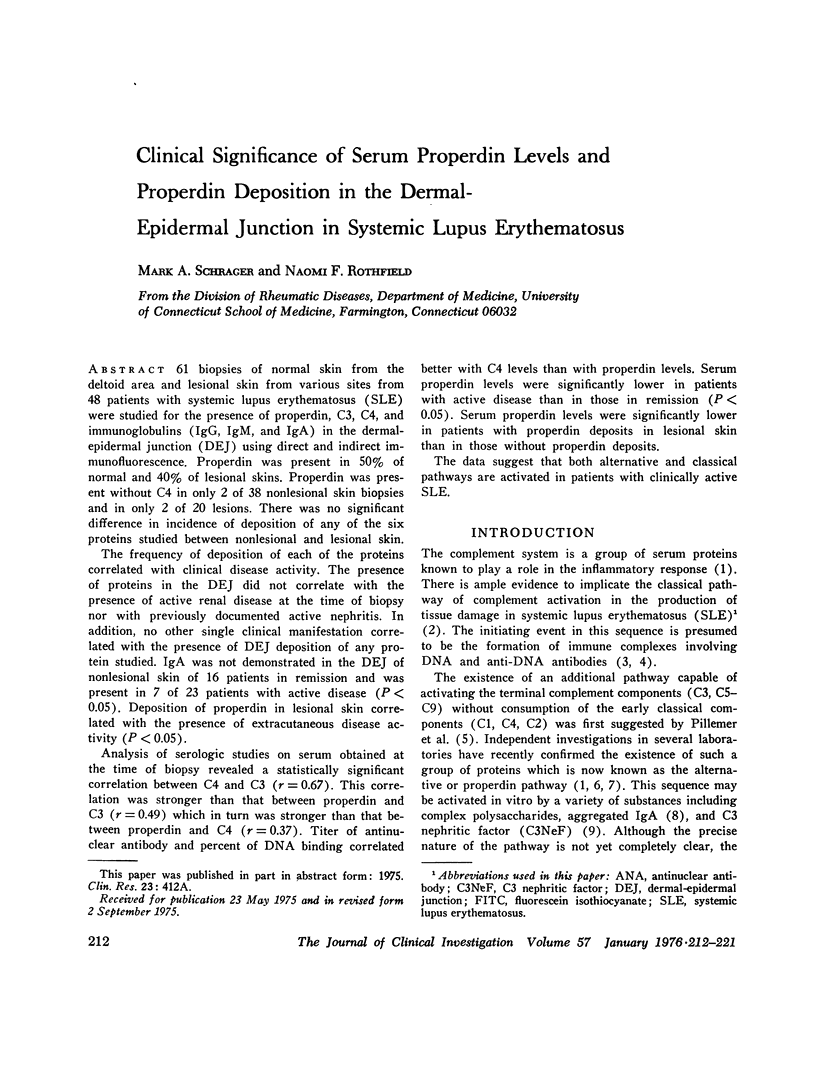
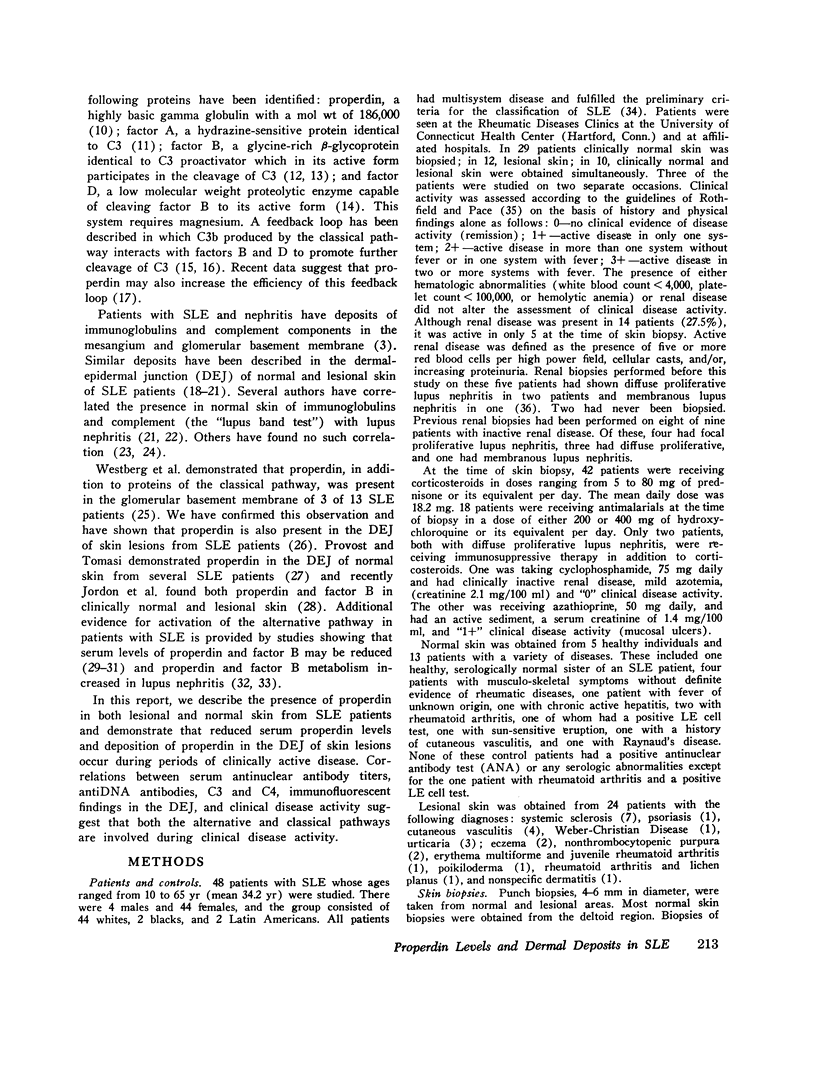
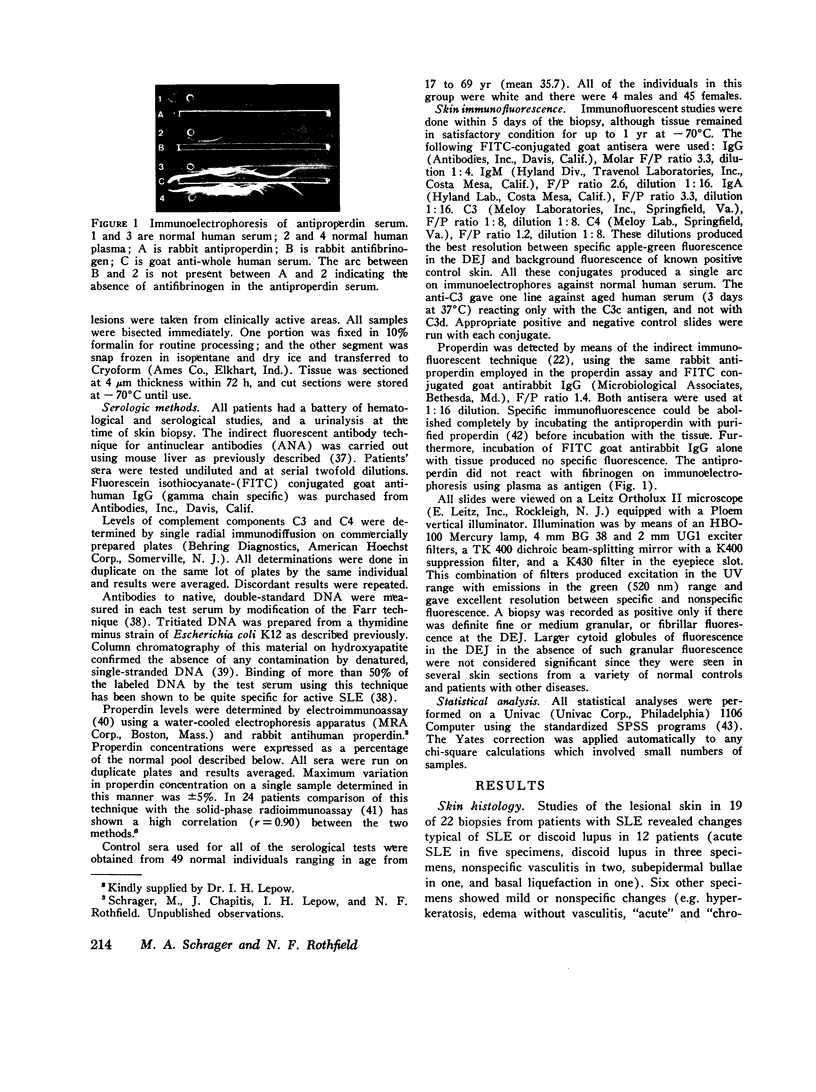
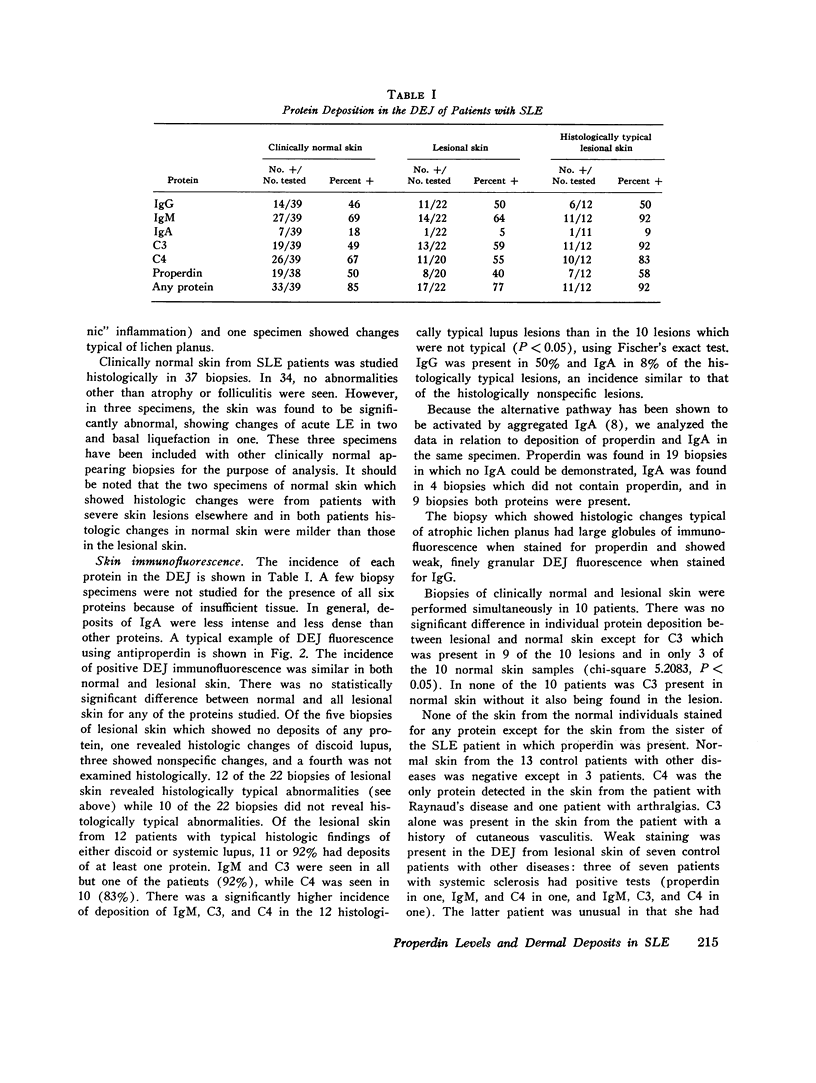
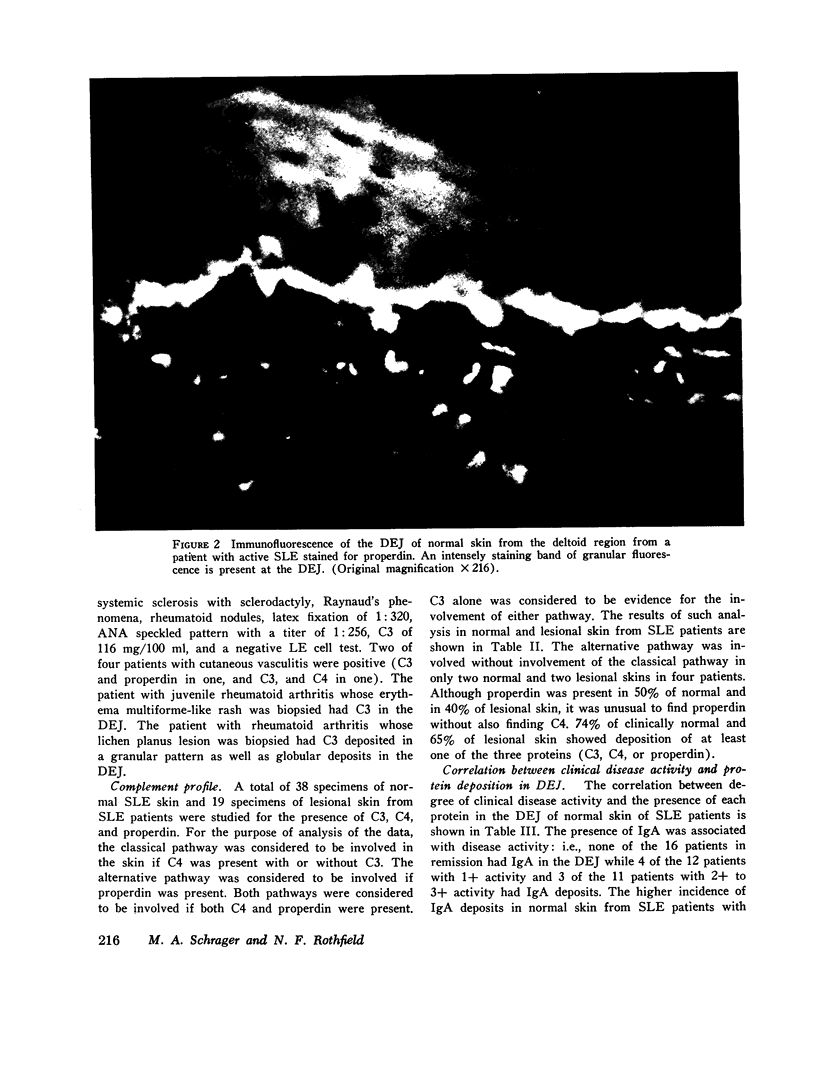
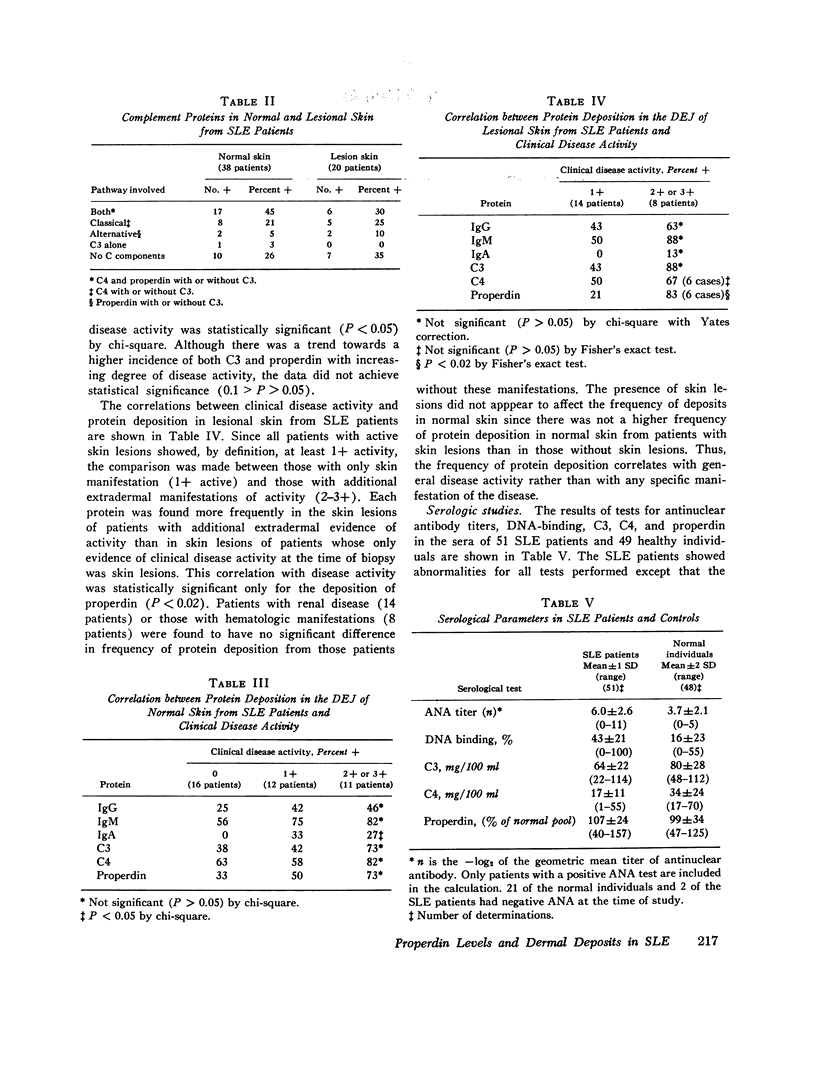
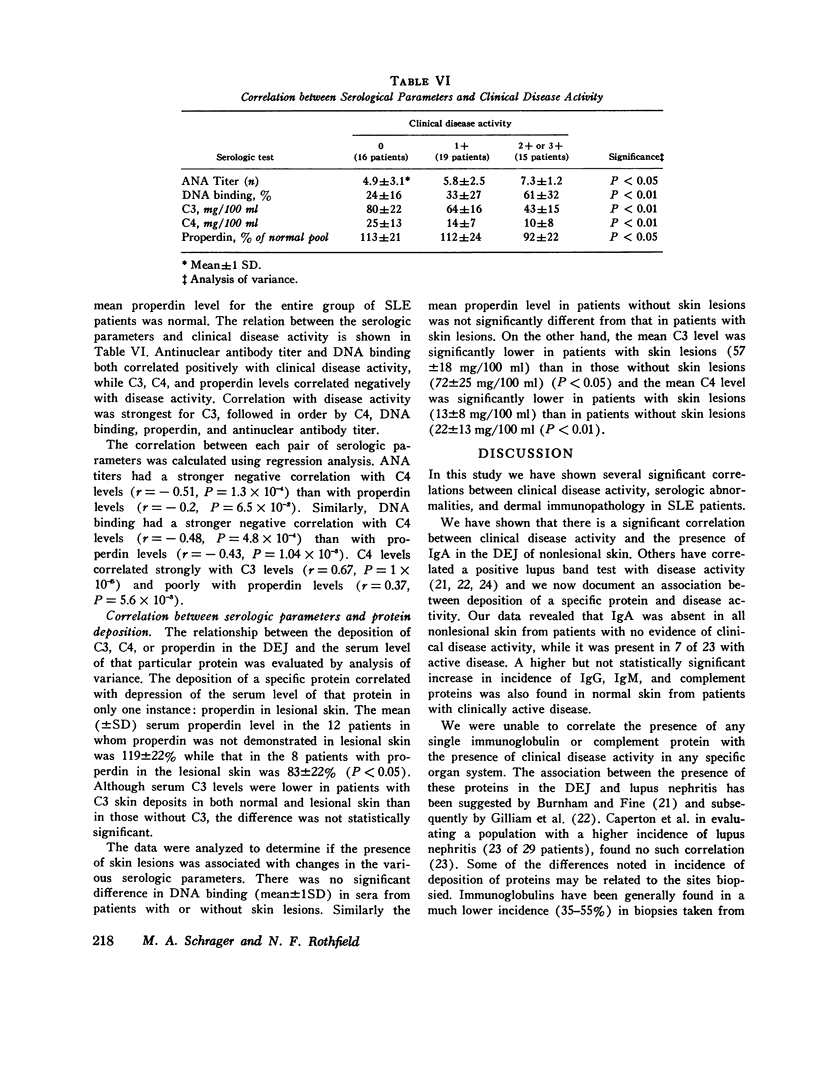
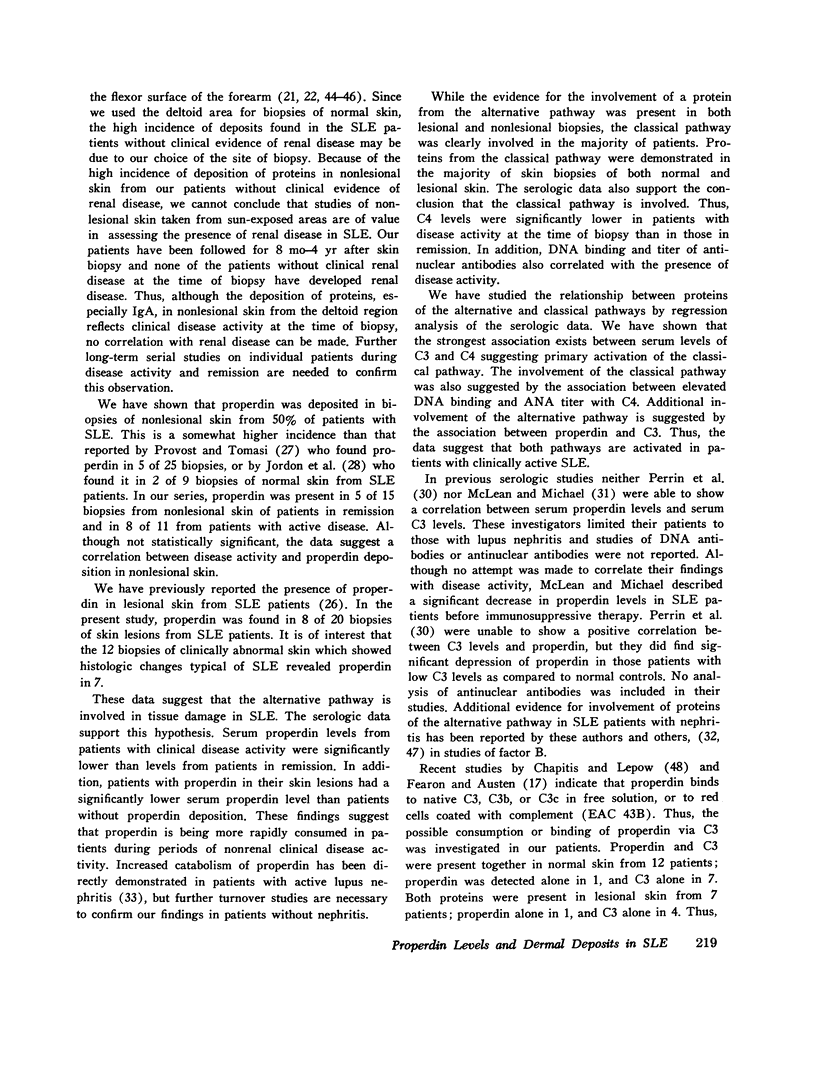
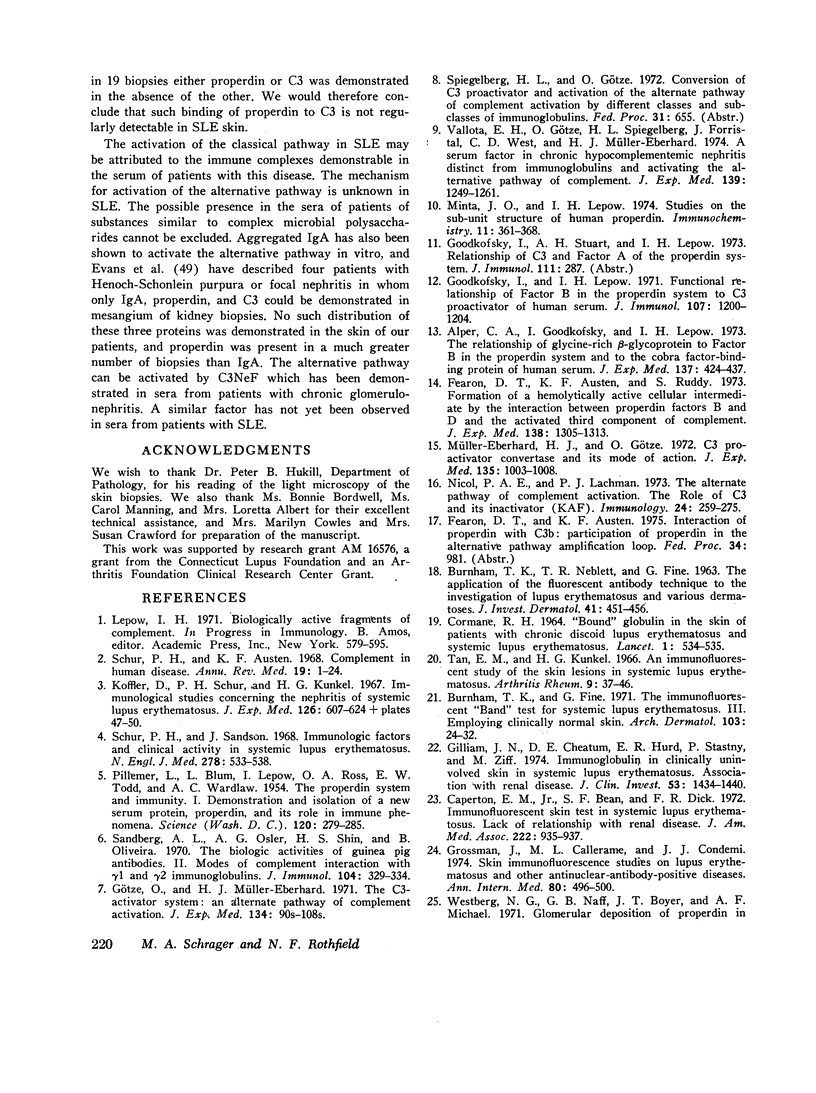
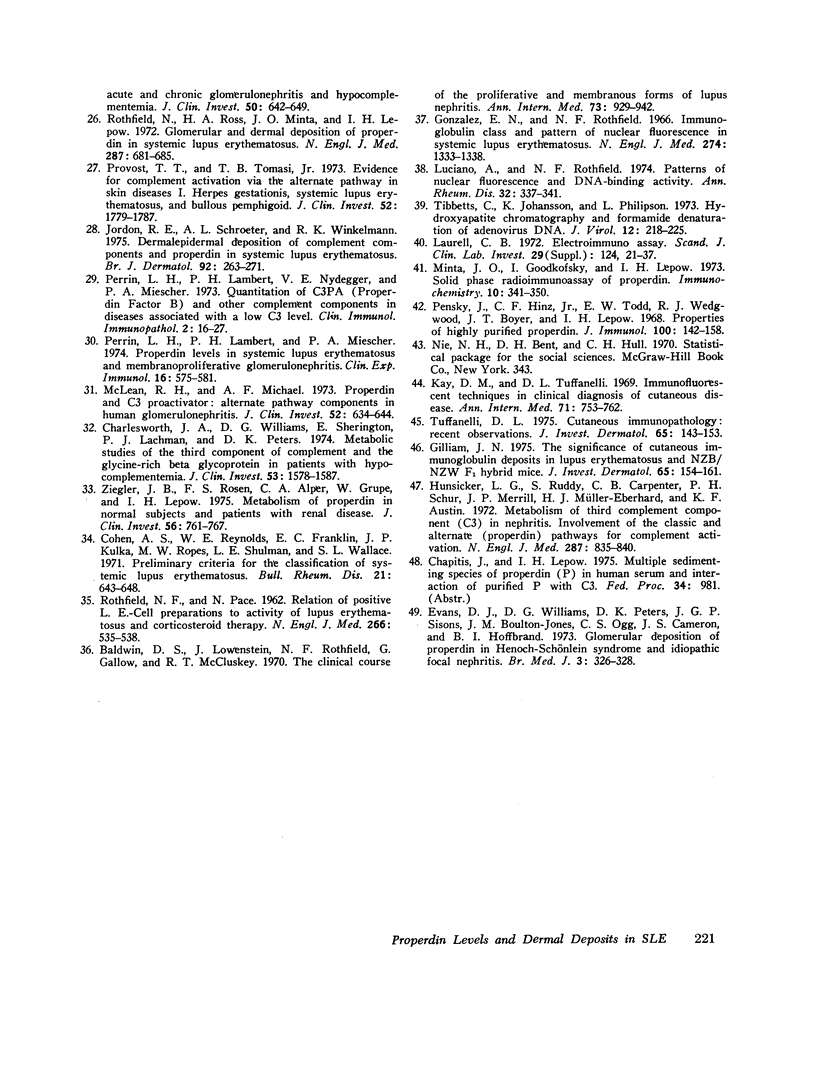
Images in this article
Selected References
These references are in PubMed. This may not be the complete list of references from this article.
- Alper C. A., Goodkofsky I., Lepow I. H. The relationship of glycine-rich -glycoprotein to factor B in the properdin system and to the cobra factor-binding protein of huan serum. J Exp Med. 1973 Feb 1;137(2):424–437. doi: 10.1084/jem.137.2.424. [DOI] [PMC free article] [PubMed] [Google Scholar]
- BURNHAM T. K., NEBLETT T. R., FINE G. THE APPLICATION OF THE FLUORESCENT ANTIBODY TECHNIC TO THE INVESTIGATION OF LUPUS ERYTHEMATOSUS AND VARIOUS DERMATOSES. J Invest Dermatol. 1963 Dec;41:451–456. doi: 10.1038/jid.1963.140. [DOI] [PubMed] [Google Scholar]
- Baldwin D. S., Lowenstein J., Rothfield N. F., Gallo G., McCluskey R. T. The clinical course of the proliferative and membranous forms of lupus nephritis. Ann Intern Med. 1970 Dec;73(6):929–942. doi: 10.7326/0003-4819-73-6-929. [DOI] [PubMed] [Google Scholar]
- Burnham T. K., Fine G. The immunofluorescent "band" test for lupus erythematosus. 3. Employing clinically normal skin. Arch Dermatol. 1971 Jan;103(1):24–32. [PubMed] [Google Scholar]
- CORMANE R. H. "BOUND" GLOBULIN IN THE SKIN OF PATIENTS WITH CHRONIC DISCOID LUPUS ERYTHEMATOSUS AND SYSTEMIC LUPUS ERYTHEMATOSUS. Lancet. 1964 Mar 7;1(7332):534–535. doi: 10.1016/s0140-6736(64)92917-4. [DOI] [PubMed] [Google Scholar]
- Caperton E. M., Jr, Bean S. F., Dick F. R. Immunofluorescent skin test in systemic lupus erythematosus. Lack of relationship with renal disease. JAMA. 1972 Nov 20;222(8):935–937. [PubMed] [Google Scholar]
- Charlesworth J. A., Williams D. G., Sherington E., Lachmann P. J., Peters D. K. Metabolic studies of the third component of complement and the glycine-rich beta glycoprotein in patients with hypocomplementemia. J Clin Invest. 1974 Jun;53(6):1578–1587. doi: 10.1172/JCI107708. [DOI] [PMC free article] [PubMed] [Google Scholar]
- Ensky J., Hinz C. F., Jr, Todd E. W., Wedgwood R. J., Boyer J. T., Lepow I. H. Properties of highly purified human properdin. J Immunol. 1968 Jan;100(1):142–158. [PubMed] [Google Scholar]
- Evans D. J., Williams D. G., Peters D. K., Sissons J. G., Boulton-Jones J. M., Ogg C. S., Cameron J. S., Hoffbrand B. I. Glomerular deposition of properdin in Henoch-Schönlein syndrome and idiopathic focal nephritis. Br Med J. 1973 Aug 11;3(5875):326–328. doi: 10.1136/bmj.3.5875.326. [DOI] [PMC free article] [PubMed] [Google Scholar]
- Fearon D. T., Austen K. F., Ruddy S. Formation of a hemolytically active cellular intermediate by the interaction between properdin factors B and D and the activated third component of complement. J Exp Med. 1973 Dec 1;138(6):1305–1313. doi: 10.1084/jem.138.6.1305. [DOI] [PMC free article] [PubMed] [Google Scholar]
- Gilliam J. N., Cheatum D. E., Hurd E. R., Stastny P., Ziff M. Immunoglobulin in clinically uninvolved skin in systemic lupus erythematosus: association with renal disease. J Clin Invest. 1974 May;53(5):1434–1440. doi: 10.1172/JCI107691. [DOI] [PMC free article] [PubMed] [Google Scholar]
- Gilliam J. N. The significance of cutaneous immunoglobulin deposits in lupus erythematosus and NZB/NZW F1 hybrid mice. J Invest Dermatol. 1975 Jul;65(1):154–161. doi: 10.1111/1523-1747.ep12598109. [DOI] [PubMed] [Google Scholar]
- Gonzalez E. N., Rothfield N. F. Immunoglobulin class and pattern of nuclear fluorescence in systemic lupus erythematosus. N Engl J Med. 1966 Jun 16;274(24):1333–1338. doi: 10.1056/NEJM196606162742401. [DOI] [PubMed] [Google Scholar]
- Goodkofsky I., Lepow I. H. Functional relationship of factor B in the properdin system to C3 proactivator of human serum. J Immunol. 1971 Oct;107(4):1200–1204. [PubMed] [Google Scholar]
- Grossman J., Callerame M. L., Condemi J. J. Skin immunofluorescence studies on lupus erythematosus and other antinuclear-antibody-positive diseases. Ann Intern Med. 1974 Apr;80(4):496–500. doi: 10.7326/0003-4819-80-4-496. [DOI] [PubMed] [Google Scholar]
- Götze O., Müller-Eberhard H. J. The C3-activator system: an alternate pathway of complement activation. J Exp Med. 1971 Sep 1;134(3 Pt 2):90s–108s. [PubMed] [Google Scholar]
- Hunsicker L. G., Ruddy S., Carpenter C. B., Schur P. H., Merrill J. P., Müller-Eberhard H. J., Austen K. F. Metabolism of third complement component (C3) in nephritis. Involvement of the classic and alternate (properdin) pathways for complement activation. N Engl J Med. 1972 Oct 26;287(17):835–840. doi: 10.1056/NEJM197210262871701. [DOI] [PubMed] [Google Scholar]
- Jordon R. E., Schroeter A. L., Winkelmann R. K. Dermal-epidermal deposition of complement components and properdin in systemic lupus erythematosus. Br J Dermatol. 1975 Mar;92(3):263–271. doi: 10.1111/j.1365-2133.1975.tb03075.x. [DOI] [PubMed] [Google Scholar]
- Kay D. M., Tuffanelli D. L. Immunofluorescent techniques in clinical diagnosis of cutaneous disease. Ann Intern Med. 1969 Oct;71(4):753–762. doi: 10.7326/0003-4819-71-4-753. [DOI] [PubMed] [Google Scholar]
- Koffler D., Schur P. H., Kunkel H. G. Immunological studies concerning the nephritis of systemic lupus erythematosus. J Exp Med. 1967 Oct 1;126(4):607–624. doi: 10.1084/jem.126.4.607. [DOI] [PMC free article] [PubMed] [Google Scholar]
- Laurell C. B. Electroimmuno assay. Scand J Clin Lab Invest Suppl. 1972;124:21–37. doi: 10.3109/00365517209102748. [DOI] [PubMed] [Google Scholar]
- Luciano A., Rothfield N. F. Patterns of nuclear fluorescence and DNA-binding activity. Ann Rheum Dis. 1973 Jul;32(4):337–341. doi: 10.1136/ard.32.4.337. [DOI] [PMC free article] [PubMed] [Google Scholar]
- McLean R. H., Michael A. F. Properdin anc C3 proactivator: alternate pathway components in human glomerulonephritis. J Clin Invest. 1973 Mar;52(3):634–644. doi: 10.1172/JCI107225. [DOI] [PMC free article] [PubMed] [Google Scholar]
- Minta J. O., Goodkofsky I., Lepow I. H. Solid phase radioimmunoassay of properdin. Immunochemistry. 1973 May;10(5):341–350. doi: 10.1016/0019-2791(73)90082-7. [DOI] [PubMed] [Google Scholar]
- Minta J. O., Lepow I. H. Studies on the sub-unit structure of human properdin. Immunochemistry. 1974 Jul;11(7):361–368. doi: 10.1016/0019-2791(74)90189-x. [DOI] [PubMed] [Google Scholar]
- Müller-Eberhard H. J., Götze O. C3 proactivator convertase and its mode of action. J Exp Med. 1972 Apr 1;135(4):1003–1008. doi: 10.1084/jem.135.4.1003. [DOI] [PMC free article] [PubMed] [Google Scholar]
- Nicol P. A., Lachmann P. J. The alternate pathway of complement activation. The role of C3 and its inactivator (KAF). Immunology. 1973 Feb;24(2):259–275. [PMC free article] [PubMed] [Google Scholar]
- PILLEMER L., BLUM L., LEPOW I. H., ROSS O. A., TODD E. W., WARDLAW A. C. The properdin system and immunity. I. Demonstration and isolation of a new serum protein, properdin, and its role in immune phenomena. Science. 1954 Aug 20;120(3112):279–285. doi: 10.1126/science.120.3112.279. [DOI] [PubMed] [Google Scholar]
- Perrin L. H., Lambert P. H., Miescher P. A. Properdin levels in systemic lupus erythematosus and membranoproleferative glomerulonephritis. Clin Exp Immunol. 1974 Apr;16(4):575–581. [PMC free article] [PubMed] [Google Scholar]
- Perrin L. H., Lambert P. H., Nydegger U. E., Miescher P. A. Quantitation of C3PA (properdin factor B) and other complement components in diseases associated with a low C3 level. Clin Immunol Immunopathol. 1973 Nov;2(1):16–27. doi: 10.1016/0090-1229(73)90032-9. [DOI] [PubMed] [Google Scholar]
- Provost T. T., Tomasi T. B., Jr Evidence for complement activation via the alternate pathway in skin diseases, I. Herpes gestationis, systemic lupus erythematosus, and bullous pemphigoid. J Clin Invest. 1973 Jul;52(7):1779–1787. doi: 10.1172/JCI107359. [DOI] [PMC free article] [PubMed] [Google Scholar]
- ROTHFIELD N. F., PACE N. Relation of positive L.E.-cell preparations to activity of lupus erythematosus and corticosteroid therapy. N Engl J Med. 1962 Mar 15;266:535–538. doi: 10.1056/NEJM196203152661103. [DOI] [PubMed] [Google Scholar]
- Rothfield N., Ross H. A., Minta J. O., Lepow I. H. Glomerular and dermal depostion of properdin in systemic lupus erythematosus. N Engl J Med. 1972 Oct 5;287(14):681–685. doi: 10.1056/NEJM197210052871402. [DOI] [PubMed] [Google Scholar]
- Sandberg A. L., Osler A. G., Shin H. S., Oliveira B. The biologic activities of guinea pig antibodies. II. Modes of complement interaction with gamma 1 and gamma 2-immunoglobulins. J Immunol. 1970 Feb;104(2):329–334. [PubMed] [Google Scholar]
- Schur P. H., Austen K. F. Complement in human disease. Annu Rev Med. 1968;19:1–24. doi: 10.1146/annurev.me.19.020168.000245. [DOI] [PubMed] [Google Scholar]
- Schur P. H., Sandson J. Immunologic factors and clinical activity in systemic lupus erythematosus. N Engl J Med. 1968 Mar 7;278(10):533–538. doi: 10.1056/NEJM196803072781004. [DOI] [PubMed] [Google Scholar]
- Tan E. M., Kunkel H. G. An immunofluorescent study of the skin lesions in systemic lupus erythematosus. Arthritis Rheum. 1966 Feb;9(1):37–46. doi: 10.1002/art.1780090105. [DOI] [PubMed] [Google Scholar]
- Tibbetts C., Johansson K., Philipson L. Hydroxyapatite chromatography and formamide denaturation of adenovirus DNA. J Virol. 1973 Aug;12(2):218–225. doi: 10.1128/jvi.12.2.218-225.1973. [DOI] [PMC free article] [PubMed] [Google Scholar]
- Tuffanelli D. L. Cutaneous immunopathology: recent observations. J Invest Dermatol. 1975 Jul;65(1):143–153. doi: 10.1111/1523-1747.ep12598101. [DOI] [PubMed] [Google Scholar]
- Vallota E. H., Götze O., Spiegelberg H. L., Forristal J., West C. D., Müller-Eberhard H. J. A serum factor in chronic hypocomplementemic hephritis distinct from immunoglobulins and activating the alternate pathway of complement. J Exp Med. 1974 May 1;139(5):1249–1261. doi: 10.1084/jem.139.5.1249. [DOI] [PMC free article] [PubMed] [Google Scholar]
- Westberg N. G., Naff G. B., Boyer J. T., Michael A. F. Glomerular deposition of properdin in acute and chronic glomerulonephritis with hypocomplementemia. J Clin Invest. 1971 Mar;50(3):642–649. doi: 10.1172/JCI106534. [DOI] [PMC free article] [PubMed] [Google Scholar]
- Ziegler J. B., Rosen F. S., Alper C. A., Grupe W., Lepow I. H. Metabolism of properdin in normal subjects and patients with renal disease. J Clin Invest. 1975 Sep;56(3):761–767. doi: 10.1172/JCI108147. [DOI] [PMC free article] [PubMed] [Google Scholar]




